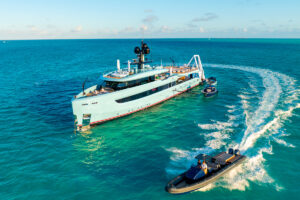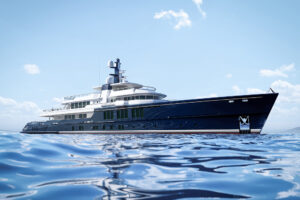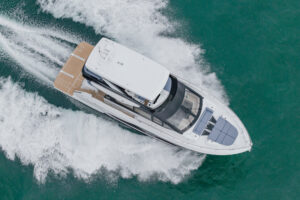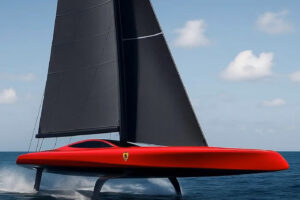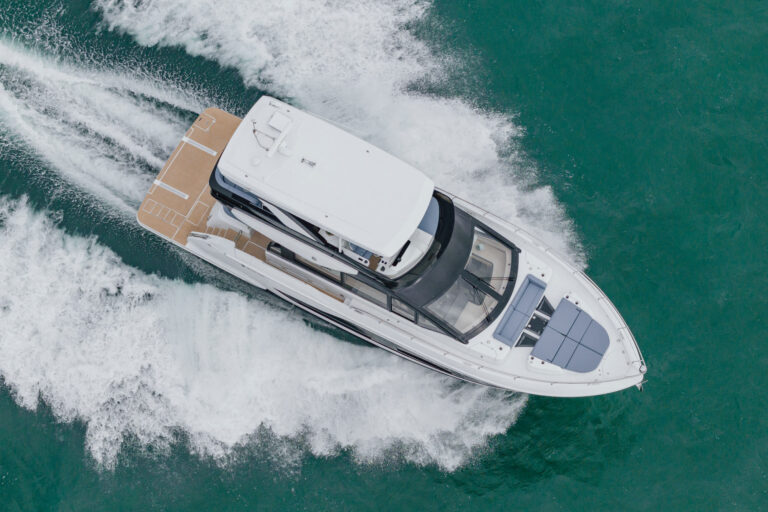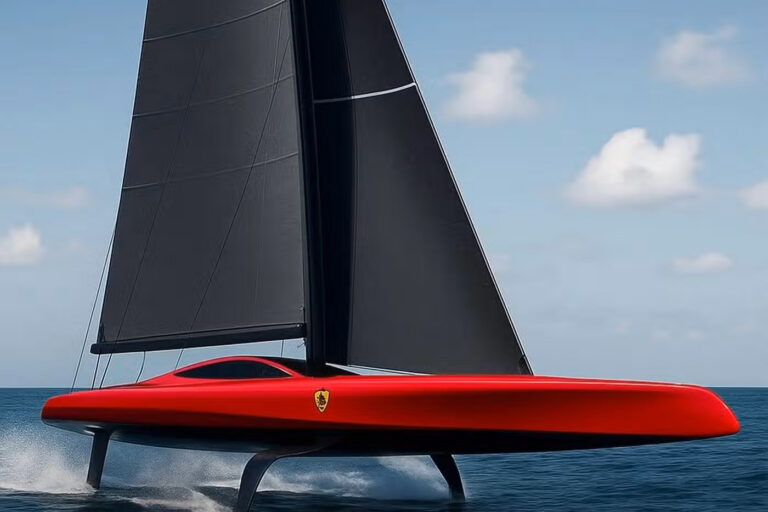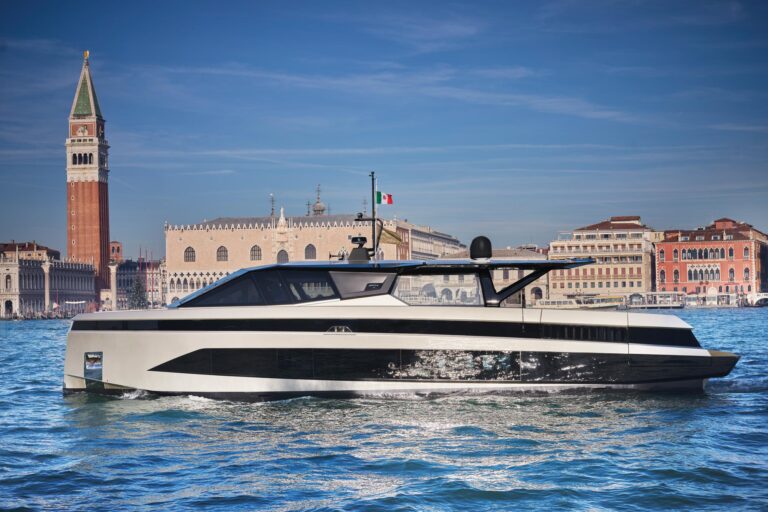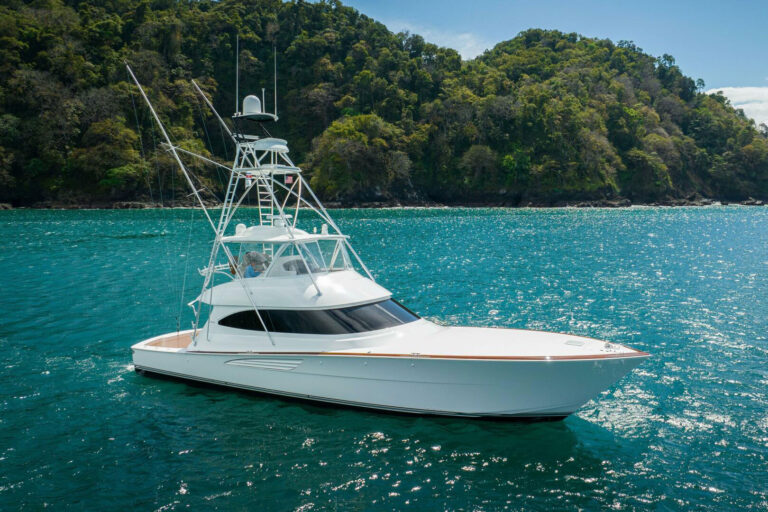














Very few yacht builders can include a depression and a world war in their histories. There are even fewer in which the founding family has managed to keep sawing wood throughout. In fact, only one comes to my mind — Huckins Yacht. How is this possible given the fragile economy of boatbuilding? Cindy Purcell will tell you it’s all about family and her grandfather, the yard’s founder, Frank Pembroke Huckins.
The title of Huckins’ memoir, Boats and Women: The History of My Life, offers a sense of the man’s wit. “Granddaddy tended to ‘say it like it was’ before it was the fashion,” said Purcell, who now runs the yard with her husband, Buddy. It was his persistence, however, that served him best. It took the patina of two marriages before he met his match and several successes and failures in business before he focused on his life’s passion — boats.
Born in east Boston in 1886, Huckins credited his father (a lumberyard owner) for his business instinct and his mother for his creativity. Huckins claimed that he pedaled his lathe “several times around the world” and that neighborhood kids wondered what “Huck the cellar boy” was up to. Huckins built a rowboat at age 12 and by age 15 was operating what he described as “a water taxi service for the lovelorn.” One of his creations, a small brass cannon, almost caused his expulsion from Harvard. “Granddaddy fired the cannon from his dorm room window and it flew out, just missing his professor on the street below,” Purcell explained.
Huckins was a lackluster student; however, his mechanical ability impressed professor Lionel S. Marks, author of The Mechanical Engineer’s Manual — the bible of the breed. Huckins credited Marks with teaching him the skills to imagine, research and create. Huckins left school to work in the lumberyard for a dollar a day, and when his father passed away he took charge — he was just 20. After selling the family business, Huckins cruised a 38-foot displacement design he had built to Florida, where he invested in a lumber mill that became home to the Florida Fairform Finish — precursor to his Fairform Flyer yacht brand.
By 1927 the Florida land boom was bust, as was Huckins. When all seemed lost, Huckins married the love of his life, Betty Archibald, and set his mind to boats. With borrowed money he launched his boatbuilding business in 1928 and acted on his dream to design and build a seagoing planing boat. Huckins’ avant-garde approach to boatbuilding was clear from the start. Instead of a traditional multipiece keel with a separate stem timber, all were laminated as one. Copper rivets secured single-planked topsides and double diagonal bottoms. Hull No. 1 measured 42 feet and was completed in July 1928. She cruised at 20 knots with a pair of 125-horsepower gasoline engines.
Huckins skippered his new boat to New England to display the yard’s capabilities. When tire magnate David M. Goodrich saw her, he addressed Huckins directly. “Young man, I understand that you build an excellent boat. … We have mutual friends to whom I have talked and I would like you to build me a boat.” Goodrich bought Hull No. 1 for $15,000 and became a good customer. A booth at the 1929 New York Boat Show yielded six orders, and to keep pace, Huckins developed a modular approach to construction.
The stock market crash cost Huckins several contracts, and he spent hours at the drawing board figuring out ways to make his boats more affordable. The first were simply smaller designs (a 25-footer for $2,000) but he sought economy in larger boats as well. Engines were mounted on I-beams supported by the engine room bulkheads, and Huckins experimented with a belt driven V-drive. Innovations like these improved performance and simplified construction. Huckins melded his methods into a standard the yard would follow for the next two decades.
When Huckins built you a boat there was little give-and-take — hulls were gray, superstructures were blue, and the interiors were cream. “Granddaddy didn’t care for brightwork — he wanted his boats to be used … not worked on.” Huckins was also aware of the negative effect excess weight had on performance. “Granddaddy felt his boats came with everything you needed — you put your feet in the boat and got under way,” said Purcell, who remembers Huckins hanging out his office window, chiding customers with a bullhorn for overprovisioning their boats. “Even though he was irascible, his customers loved him.”
By the 1950s Huckins had moved to its current location on the Ortega River in Jacksonville, Florida, but the future of the family business was in doubt. Huckins’ son, Pembroke, had tried to work with his father but the two never sorted out a relationship. It would be Huckins’ stepson, the late Ken Archibald (Purcell’s father), who carried the torch through the 1960s and 1970s. When Huckins passed away in 1951, George Pillsbury (who had helped build hull No. 1) managed the shop, and Ray Teller guarded the secrets of the Quadraconic hull form, developed by Bob Steward, whom Teller had brought aboard to handle engineering.
“When Buddy and I came into the picture in the 1970s, Dad, George and Bob were our mentors,” Purcell said. When the Purcells took charge of the yard in the 1980s the market was changing. “We knew we had to adapt to survive and we built the sorts of boats our customers asked for,” Purcell said. So began the yard’s evolution beyond Frank Huckins’ singular vision of the perfect boat. One example, Purcell said, is flybridges. “Granddaddy hated them because he felt they added too much weight — he called them Roman chariots.” Some of the yard’s new creations were truly unique. The 50-foot motoryacht Island Queen was outboard-powered while the 78-foot_ Princess Pat_ had surface drives.
Many of these designs were based on Steward’s new wide-body Quadraconic hull form. Steward also shepherded the yard to cored fiberglass construction and engineered the largest cored fiberglass boat of its day — the 76-foot motoryacht Deep Stuff launched in 1977. While the yard stayed busy, it was a difficult period for the Huckins brand. “If we built a traditionally styled Huckins, people didn’t realize our construction was state-of-the-art … If we built a modern sport-fisher, they’d say it wasn’t really a Huckins,” Purcell said.
In 1994 the Purcells went back to the drawing board, refreshing a handful of classic Huckins designs. A sports-car nut, Purcell had noticed that small, two-seat, English-style cars were making a comeback. “It seemed people were open to retro styling and we had the real deal buried in our files,” Purcell said. The designs they reintroduced were a hit, particularly my favorite, the Atlantic 44.
While it’s pleasant to reminisce, Purcell will tell you that there’s really no such thing as “the good old days” in boatbuilding — the business has always had its ups and downs. “Granddaddy had to fight for customers … So do we. You’ve got to be persistent.” Frank Huckins summed it up best. “Anyone who owns a boat is only a little less crazy than the man who tries to build them.” We’re lucky that craziness for boats runs in the Huckins and Purcell families.
View a copy of the original “Shirt Letter.”
Huckins Yacht, 904-389-1125; www.huckinsyacht.com

